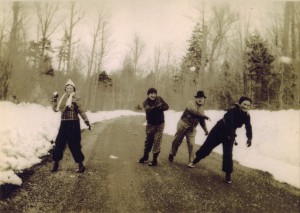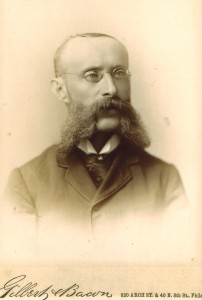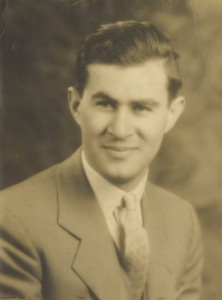[Editor’s note: This blog post originally appeared in Vita Brevis on 6 January 2016.]

Coming from a family of active amateur photographers, the (still) new digital age of photography has significantly changed the way I look at and convey my world, its events, my life, and my family. Gone are the days of, “Oh, no, I just got to the end of a 36-exposure roll and missed the perfect picture I’ll never get again.” With three expensive cameras sitting in my closet collecting dust, like many of us I now use my smart phone for most of my photographic pursuits. This is not such a bad thing: it’s always in my pocket ready to get, as DeWitt Jones says, “not just a good frame, but a great frame.”
Photographs can often tell us about our predecessors and the visual environment in which they lived and worked…
My photographic interests have always been tied to my genealogical journey. There have been many surprises along the way, convincing me that, along with the importance of oral history documentation, photographic documentation of one’s ancestors can often tell much more than words on a page (with apologies and respect to the talented and gifted researchers, writers, and editors at NEHGS). Photographs can often tell us about our predecessors and the visual environment in which they lived and worked, the kinds of clothes they wore, hair styles, facial and hand expressions, and other relatives and friends who might also be in the photograph.
Three examples come to mind: my grandmother, Alice Selig Harris (1890–1991), very much a “Victorian,” was also known as the prankster of her generation. My favorite picture of her is with friends on a snowy road in Williamsport, Pennsylvania, throwing a snowball at the camera. Looks like she had a great arm!

A second example is of my great-great-great-great-grandfather, Nathan Rosenau (1835–1930), who came to this country from Bad Kissingen in Germany. Those who recognize me (if you don’t, check out the Staff Directory at Americanancestors.org/ Development) know I sport a moustache and modest beard. But not like the one of my forebear Nathan! Maybe I should! It’s impressive. Should I try?
The third example, and the one most poignant, involves my father (Bertram Harvey Solomon, 1908–1945), whom I never knew. He died late in October of 1945 (I was born in May of that year) of an embolism following a successful hernia operation. When my mother (Ellen Harris Solomon, 1914–2011) moved from her apartment in Philadelphia to Washington, D.C., to live with my brother (Richard Harvey Solomon, born in 1937), I was assigned the task of cleaning out her basement storage locker, which contained several canisters of 16-mm film I had ever seen before.

I took the film to a local camera store and watched, absolutely fascinated, the remarkable footage of my father, pre-1945, at my older brother’s birthday party (along with assorted other recognizable family, friends, and neighbors and another brother, Tommy [1939–1944]). Other moments captured him playing golf, in the ocean at Atlantic City, and, with my mother, at the furniture factory they represented in Hickory, North Carolina. This was an emotional experience, and brought tears to my eyes. I finally had “met” the man – my father – whom I never knew except through stories from my mother and his mother (Katherine Harvey Solomon, 1879–1973). What a difference a photograph or film can make in getting to know more about one’s ancestors!
And where will your family find that shoe box of photos to pass around the Thanksgiving table? Will you all be passing telephones around?
No don’t try that beard, unless you can stand it:) I like the clean shaven photo best of your father really:) I agree with you completely, the old black & white photos my parents and grandparents have are so much more interesting to help document their lives. Where they lived when I was little/ I knew they moved me & my siblings often, the background of the homes and streets where they were are so valuable. I finally got together a collection of scans for one place & sent them to the Library there. The town has changed so much, the Librarian said it helped to document how the place looked that is so different now even though she didn’t know the people in the photos (who were mainly us and neighbors) am hoping people researching in that Library enjoy seeing them. Backgrounds in the photos are great. Now I often share some from other places we’ve lived on Facebook, most have some kind of collection site. One in New Jersey I remember because it is where I went to Elementary school has a wonderful site online.
There is nothing like a picture. I use my phone as a camera too but I still like to be able to show family and friends photos in a book. So in the past few years I’ve started uploading favorite images to a certain known retailer’s photo center and generate books as keepsakes. I can add captions and identify people and places – the added bonus is people in future years will be able to read them because it’s not my scribble – lol!
1) the beard’s just fine, although it could be somewhat bushier. Of course I don’t know if “usandall” is female, but I suspect so, having found from first-hand experience that there is very often a great aversion among women to beards; and such women tend not to wait to be asked before expressing themselves on the question!
2) I’d say you’ve assigned at least one and maybe two too many “greats” to Nathan Rosenau. I was born in 1944 and the average year of birth of my four great-grandfathers was 1839.
Yes am female, have no aversion to beards, it’s just that they are too warm in hot weather from experience with male members of our family:) You missed my point about the main topic however. Wonderful to have memorabilia that has plenty of old photographs and being happy to share them for many different reasons:)
Age at time of marriage, the size of families, as well as second and third marriages with children have a great deal to do with how many “greats” can fit into a given time span. I was born in late 1942, when my father was 31. My grandfathers were born in 1889 and 1883. My four great-grandfathers were born in 1851, 1855, 1861, and 1861. My eight great-greats were born in 1818, 1809, 1834, 1832, 1829, 1807, 1824, and 1833. The greats married women close to their own age. Most of the great-greats married women much younger than they (a number of second marriages with issue). If they had been younger men, there very likely could have been time enough to squeeze another generation in there, though possibly one more than that would be unrealistic. There were many families in which mothers and daughters bore children during the same year, or fathers with children and grandchildren of similar age. That can turn counting generations into a logistical challenge.
It is worthwhile to note that Steve did ask for our opinions. Usandall simply expressed her own take on the matter, which is that bushy beards can be uncomfortably warm. She did not express a personal preference until after you expressed an (uninvited) opinion about women having an opinion. To which I will add mine: I like beards on men, but do prefer them neatly trimmed rather than bushy. I live in a place where men grow beards for winter, and shave them in summer, which makes life interesting.